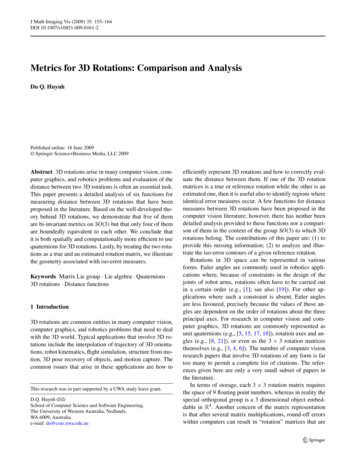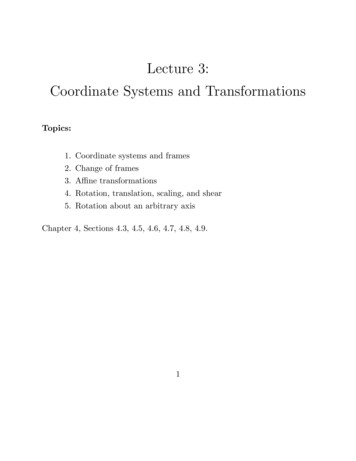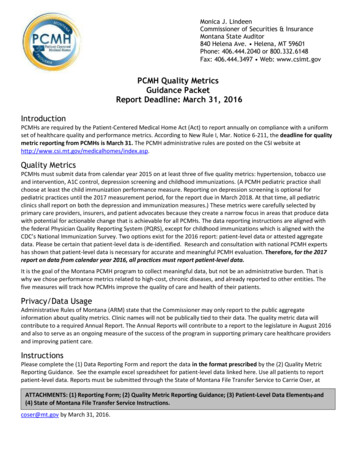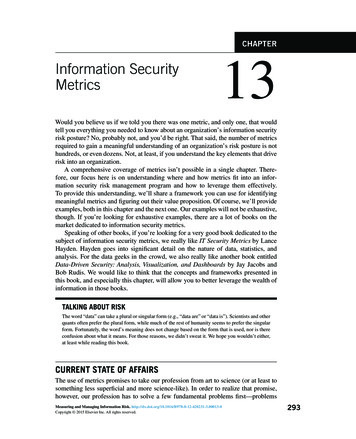
Transcription
J Math Imaging Vis (2009) 35: 155–164DOI 10.1007/s10851-009-0161-2Metrics for 3D Rotations: Comparison and AnalysisDu Q. HuynhPublished online: 18 June 2009 Springer Science Business Media, LLC 2009Abstract 3D rotations arise in many computer vision, computer graphics, and robotics problems and evaluation of thedistance between two 3D rotations is often an essential task.This paper presents a detailed analysis of six functions formeasuring distance between 3D rotations that have beenproposed in the literature. Based on the well-developed theory behind 3D rotations, we demonstrate that five of themare bi-invariant metrics on SO(3) but that only four of themare boundedly equivalent to each other. We conclude thatit is both spatially and computationally more efficient to usequaternions for 3D rotations. Lastly, by treating the two rotations as a true and an estimated rotation matrix, we illustratethe geometry associated with iso-error measures.Keywords Matrix Lie group · Lie algebra · Quaternions ·3D rotations · Distance functions1 Introduction3D rotations are common entities in many computer vision,computer graphics, and robotics problems that need to dealwith the 3D world. Typical applications that involve 3D rotations include the interpolation of trajectory of 3D orientations, robot kinematics, flight simulation, structure from motion, 3D pose recovery of objects, and motion capture. Thecommon issues that arise in these applications are how toThis research was in part supported by a UWA study leave grant.D.Q. Huynh ( )School of Computer Science and Software Engineering,The University of Western Australia, Nedlands,WA 6009, Australiae-mail: du@csse.uwa.edu.auefficiently represent 3D rotations and how to correctly evaluate the distance between them. If one of the 3D rotationmatrices is a true or reference rotation while the other is anestimated one, then it is useful also to identify regions whereidentical error measures occur. A few functions for distancemeasures between 3D rotations have been proposed in thecomputer vision literature; however, there has neither beendetailed analysis provided to these functions nor a comparison of them in the context of the group SO(3) to which 3Drotations belong. The contributions of this paper are: (1) toprovide this missing information; (2) to analyze and illustrate the iso-error contours of a given reference rotation.Rotations in 3D space can be represented in variousforms. Euler angles are commonly used in robotics applications where, because of constraints in the design of thejoints of robot arms, rotations often have to be carried outin a certain order (e.g., [1]; see also [19]). For other applications where such a constraint is absent, Euler anglesare less favoured, precisely because the values of these angles are dependent on the order of rotations about the threeprincipal axes. For research in computer vision and computer graphics, 3D rotations are commonly represented asunit quaternions (e.g., [5, 15, 17, 18]), rotation axes and angles (e.g., [8, 21]), or even as the 3 3 rotation matricesthemselves (e.g., [3, 4, 6]). The number of computer visionresearch papers that involve 3D rotations of any form is fartoo many to permit a complete list of citations. The references given here are only a very small subset of papers inthe literature.In terms of storage, each 3 3 rotation matrix requiresthe space of 9 floating point numbers, whereas in reality thespecial orthogonal group is a 3 dimensional object embeddable in R4 . Another concern of the matrix representationis that after several matrix multiplications, round-off errorswithin computers can result in “rotation” matrices that are
156J Math Imaging Vis (2009) 35: 155–164no longer orthogonal. In that regard, the unit quaternionsare preferred as an alternative way of representing 3D rotations. Although round-off errors may also cause any unitquaternion to have a non-unit magnitude, it is more straightforward to renormalize it to unity in comparison with reorthogonalizing a distorted matrix.In the following sections, we will first give a briefoverview of the special orthogonal group and the unitquaternions. This is then followed by the formal definitionof a distance function or metric. Six different functions for3D rotations will then be studied in turn; their computationcomplexity will be briefly analyzed. In Sect. 5, a geometricalinterpretation of one of the functions will be studied further,this leads to the discussion on iso-error contours. Finally inSect. 6, we conclude the paper.2 SO(3) and Unit Quaternions: An Overview3D rotations form the so-called Special Orthogonal GroupSO(3) of orthogonal matrices with determinant 1. SO(3) isa compact Lie group having the skew-symmetric matrices asits Lie algebra, so(3). This Lie algebra is a non-associativevector space equipped with a binary operation:[ · , · ] : so(3) so(3) so(3),[A, B] AB BA(1)which can easily be seen to be a closed operation in so(3).The Lie algebra so(3) is the tangent space at the identity element of SO(3). The binary operation defined above is knownas the Lie bracket, which satisfies the following properties:[A, B] [B, A],[A, [B, C]] [C, [A, B]] [B, [C, A]] 0,(2)for all A, B, C so(3). It follows immediately from the firstproperty that [A, A] 0.In the theory of Lie groups, the exponential map is a mapping from the Lie algebra of a Lie group to the group itself.Such a mapping allows one to recapture the group structurefrom its Lie algebra. As in the general case of matrix Liegroups, the exponential map exp : so(3) SO(3) is simply:exp(A) I A A2 A 3 ··· .2!3!(3)For the special orthogonal group SO(3), the exponential mapis surjective but not injective. The failure of injectivity iseasily seen by considering a skew-symmetric matrix such as 01 1A 1 0 1 (4)1 1 0and noting that exp(tA) I whenever t is an integer multiple of 2π/ 3. This example, however, suggests at leastsome of the degree of non-uniqueness in the exponentialparametrization. Indeed, the exponential parametrization ofSO(3) corresponds exactly to the rotation axis and rotation angle formulation. Given a rotation with rotation axisu (u1 , u2 , u3 ) of unit magnitude and rotation angle θ ,the 3 3 rotation matrix R can be obtained by the exponential mapping exp([θ u] ), where [ a ] is chosen to be thematrix defined by [a] b a b. For example, the matrix in(4) corresponds to [( 1, 1, 1)] . The group SO(3) is covered by one-parameter groups (in fact circles) of the form{exp([θ u] ) : θ [ π, π)} and this representation is almostunique, since a rotation uniquely specifies its (unit vector)rotation axis up to a multiplication by 1, and once this isfixed, the angle is specified up to a multiple of 2π .It is straightforward to show that the Rodrigues formula(see, e.g., [11]) for a rotation matrix R as defined belowR cos θ I sin θ [u] (1 cos θ )uu ,(5)is just a simplification of the exponential map given in (3)being applied to [θ u] . Given a 3 3 rotation matrix R,the inverse of the exponential map provides a rotation angle/axis description of the rotation. Thus, log(R) is theskew-symmetric matrix containing information about the rotation axis and angle. Although the inverse process requiresa choice of rotation axis between the two alternatives, it isa straightforward procedure to retrieve the rotation axis andangle (see Appendix A).As a unit quaternion, the same 3D rotation matrixexp([θ u] ) SO(3) can be written as q (q0 , q1 , q2 , q3 ) (q0 , q̃) (cos θ2 , u sin θ2 ) . The unit quaternions are a one-toone parametrization of the Special Unitary group SU(2) andthe q above can be written as a 2 2 unitary matrix: q0 iq1 q2 iq3.(6) q2 iq3 q0 iq1SU(2) provides a double-covering of SO(3); that is, eachrotation matrix in SO(3) corresponds to two members ofSU(2). The group homomorphism from SU(2) to SO(3)has a two element kernel and this corresponds to the ambiguity in the choice of rotation axis in the logarithmicmap. In this regard, we note that SU(2) and SO(3) havethe same Lie algebra. The Lie algebra su(2), which consists of the 2 2 skew-hermitian matrices, is isomorphic as aLie algebra to so(3). Consider representing the rotation axisu (u1 , u2 , u3 ) of unit magnitude and the rotation angleθ as a 2 2 skew-hermitian matrix, A, as follows: θ u2 iθ u3iθ u1A θ u2 iθ u3 iθ u1
J Math Imaging Vis (2009) 35: 155–164 θ157 u2 iu3 θ Ã. iu1iu1 u2 iu3(7)By applying the exponential mapping to A and noting thatA2 θ 2 I, we obtain a different version of the Rodriguesformula:exp : su(2) SU(2),exp(A) cos θ I sin θAθ(8) cos θ I sin θ Ã.It is straightforward to verify that exp(A) SU(2) and thatthe quaternions are simply a parametrization of SU(2). Theexponential map from su(2) to SU(2) does not suffer fromthe ambiguity present in the orthogonal case.3.1 DefinitionFor definiteness, we give the usual definition of distancefunction or metric. Let S be some space between whose elements we are interested in knowing distances. A distancefunction or metric is a map Φ : S S R satisfying theusual axioms for metrics:(i) Φ(x, y) 0 x y;(ii) Φ(x, y) Φ(y, x) for x, y S;(iii) Φ(x, z) Φ(x, y) Φ(y, z) for x, y, z S.We note that there are situations where our intuitive conceptof “distance” may not satisfy these axioms.There are two other properties of distance functions thatare important in the context of SO(3). The first is that the distance function defines and respects the topology of SO(3).To state precisely what this means, we note that the obviousdefinition of Rn R as n for Rn , R SO(3) is thatthe matrix entries of the Rn should converge to the matrixentries of R as real numbers. We say that a distance functionΦ respects the topology of SO(3) providedRn R.(9)Since SO(3) is compact, it is sufficient [12] thatRn R for R1 , R2 , R3 SO(3). A distance function is bi-invariantif it is both left and right invariant.Two distance functions Φ and Ψ are said to be boundedlyequivalent if there are positive real numbers a and b suchthataΦ(R1 , R2 ) Ψ (R1 , R2 ) bΦ(R1 , R2 )Φ(Rn , R) 0.(10)It is essential that this is the case for all distance functionsdefined on SO(3).Since SO(3) is a group, we can ask one other propertyof interest. We say that a distance function Φ is left, (resp.right) invariant ifΦ(R1 R2 , R1 R3 ) Φ(R2 , R3 ),(13)for all R1 , R2 SO(3). We also define functional equivalence between Φ and Ψ to mean that there exists a positivecontinuous strictly increasing function h such thath Φ Ψ.(14)cΦ(R1 , R2 ) Φ(RR1 , RR2 ) dΦ(R1 , R2 ) (12)It is easy to see that if one distance function respects thetopology of SO(3) and another is either boundedly or functionally equivalent to it then it too respects the topology.Also, if Φ is a distance function satisfying3 Distance Function or MetricΦ(Rn , R) 0 resp. Φ(R2 R1 , R3 R1 ) Φ(R2 , R3 )(11)(15)for all R1 , R2 , R SO(3) and for some positive real numbers c and d, then it is equivalent to a left-invariant one. Theinvariant distance function isΦL (R1 , R2 ) Φ(RR1 , RR2 ) dR(16)for all R1 , R2 SO(3) where the integral is with respect tothe (left) Haar measure on the group. We note that this measure is left invariant and it is this property which ensures leftinvariance of the distance function. A similar result holdsfor right and bi-invariant distance functions. Note that, inthis case, since SO(3) is a compact group its left and rightHaar measures are the same.Finally, two metrics are said to be topologically equivalent if they give the same convergent sequences. Both functional and bounded equivalence individually imply topological equivalence. Our assumption that metrics respect thetopology means that they are topologically equivalent toeach other.Several functions for measuring the distance betweentwo 3D rotations for various applications have been reportedin the literature. Some of these functions are defined in termsof Euler angles or quaternions, while others involve the rotation matrices. We will discuss each of them in turn below.We assume that the two rotation matrices whose distanceis of interest are R1 exp([θ1 u] ) and R2 exp([θ2 v] ),where θ1 and θ2 are the rotation angles, and u and v therotation axes of unit magnitude. Their corresponding unitquaternions can be written as q1 (cos θ21 , u sin θ21 ) and q2 (cos θ22 , v sin θ22 ) , respectively. All rotationaxes are assumed to be of unit magnitude from here on.
158J Math Imaging Vis (2009) 35: 155–1643.2 Euclidean Distance between the Euler AnglesΦ3 (q1 , q2 ) min{arccos(q1 · q2 ), π arccos(q1 · q2 )},Let (α1 , β1 , γ1 ) and (α2 , β2 , γ2 ) be two sets of Euler angles.Thenwhere · denotes the inner (or dot) product of vectors (not thequaternion multiplication, which produces another quaternion). This function was used by Wunsch et al. [20] for 3Dobject pose estimation. As in (18), the ambiguity in sign ofunit quaternions must be taken into consideration. So, Φ3 can be replaced by the following computationally more efficient function:Φ1 : E E R ,Φ1 ((α1 , β1 , γ1 ), (α2 , β2 , γ2 )) (17)d(α1 , α2 )2 d(β1 , β2 )2 d(γ1 , γ2 )2 ,where E R3 is an appropriate domain for the threeEuler angles (see the discussion that follows) and d(a, b) min{ a b , 2π a b } denotes the normalized difference between the two angles so that 0 d(., .) π . Therange of values of Φ1 is [0, π 3]. This function was discussed in [9] in the context of rotation matrix sampling.Unfortunately, it is not a distance function on SO(3) sinceit depends on a representation that is not unique. For example, the Euler angles (α, β, γ ) (π, π, 0) can represent thesame rotation as (α, β, γ ) (0, 0, π) under a particular order of rotations, yet their distance is non-zero. To overcomethe problem of ambiguous representation, we can imposethe following conditions on the Euler angles (and thus thedomain E): α, γ [ π, π); β [ π/2, π/2). Under thisrepresentation, Φ1 is a metric on SO(3).3.3 Norm of the Difference of QuaternionsRavani and Roth [16] define the distance between two rotations as the Euclidean distance between two unit quaternions. As unit quaternions q and q denote the same rotation, we can define the following function, which takes intoaccount the ambiguity in quaternion representation:Φ2 : S 3 S 3 R ,Φ2 (q1 , q2 ) min{ q1 q2 , q1 q2 },Φ3 (q1 , q2 ) arccos( q1 · q2 ).(19)Since it is necessary that Φ3 is a non-negative function, werestrict the angles returned by arccos to be in the first quadrant, i.e., the range of values mapped by Φ3 is [0, π/2] (radians).Alternatively, the inverse cosine function above can beeliminated by definingΦ4 : S 3 S 3 R ,(20)Φ4 (q1 , q2 ) 1 q1 · q2 .This function was used in [9] for the distance measure between two Euclidean transformations. Function Φ4 give values in the range [0, 1].Following the same argument as that for Φ2 , we can conclude that both Φ3 and Φ4 are pseudometrics on the unitquaternions but are metrics on SO(3). Up to this point, wehave not discussed whether Φ2 , Φ3 , and Φ4 are bi-invariantmetrics on SO(3). We defer the proof for this until later inthe paper.3.5 Deviation from the Identity Matrix(18)where · denotes the Euclidean norm (or 2-norm) andS 3 {q R4 q 2 1}. We can easily verify that in theS 3 space, the Φ2 function above satisfies all axioms exceptfor Axiom (i) since Φ2 (q, q) 0 q q (as vectorsin R4 ). This means that Φ2 is a pseudometric [7] rather thana metric on the unit quaternions. However, as the mappingfrom unit quaternions to SO(3) is 2-to-1, the pseudometricon the unit quaternions becomes a metric on 3D rotationsbecause we are identifying points with zero distanceapart. The Φ2 metric gives values in the range [0, 2].3.4 Inner Product of Unit QuaternionsA similar function that involves unit quaternions is given by:Φ3 : S 3 S 3 R ,Φ3 : S 3 S 3 R ,Larochelle et al. [10] use polar decomposition to approximate elements of the Euclidean group SE(n 1) with elements of the special orthogonal group SO(n) and then employ the metric d(A1 , A2 ) I A1 A 2 F (where A1 , A2 SO(n) and · F denotes the Frobenius norm of the matrix) as a distance measure between two rigid body displacements. For the specific case where n 3, we haveΦ5 : SO(3) SO(3) R ,Φ5 (R1 , R2 ) I R1 R 2(21)F, which gives values in the range [0, 2 2]. An alternative is toreplace the Frobenius norm above by the 2-norm to reducethe range of values to [0, 2] instead.One can verify that Φ5 is a metric on SO(3) although theproof to show that the function satisfies the triangle inequality condition involves some messy algebra.
J Math Imaging Vis (2009) 35: 155–1641593.6 Geodesic on the Unit Sphere4.1 Bounded EquivalenceSince SO(3) is a compact Lie group it has a natural Riemannian metric; that is, an inner product on its tangent spaceat every point. At the identity, this tangent space is so(3),i.e., the skew-symmetric matrices, as we have mentioned.The inner product on so(3) is given byThe metrics Φi , for i 2, . . . , 6, produce values in different ranges and of different units: Φ3 and Φ6 are in radians while the other three are dimensionless. The difference in units is not an issue as a change of unit merelyresults in a scale change to the metric being considered.Furthermore, the relationships among these metrics areclearly non-linear, except for Φ3 and Φ6 . To see that Φ3and Φ6 have a linear relationship, consider the computation of the rotation angle of R1 R 2 in the definitionof Φ6 . As unit quaternions, R1 and R 2 can be, respecθ1 tively, represented by q1 (cos 2 , u sin θ21 ) and q̄2 (cos θ22 , v sin θ22 ) , where the overhead bar denotesquaternion conjugate. The cosine of half of the rotationangle of R1 R 2 can be found from the first component ofproduct q1 q̄2 , which, by definition of quaternion multiplication, is cos θ21 cos θ22 sin θ21 sin θ22 (u · v) . This term isidentical to the absolute value of the dot product of the two4-vector q1 and q2 computed in Φ3 , i.e., cos( θ2 ) q1 · q2 .Thus, Φ3 returns half of the rotation angle of R1 R 2 fromΦ6 . From the definition given in Sect. 3.1, metrics Φ3 andΦ6 are boundedly equivalent.To prove that two metrics Φi and Φj are boundedlyequivalent (see (13)), it suffices, because SO(3) is compact,to show that Φi /Φj is bounded near the origin. In particular,the metrics Φ2 and Φ5 can be rewritten as (24)Φ2 (q1 , q2 ) 2 (1 q1 · q2 ), Φ5 (R1 , R2 ) trace (I R1 R 2 ) (I R1 R2 )1 S1 , S2 trace S 1 S2 ,2(22)for S1 , S2 so(3).The inner product in the Riemannian structure providesan “infinitesimal” version of length on the tangent vectors,and so the length of a curve can be obtained by integrationalong the curve. Then the concept of a shortest path betweentwo points on the group, a geodesic, follows. In fact, it isenough to describe the shortest path from the identity of thegroup to another point which we can write as exp(S), whereS so(3). This shortest path can be shown to be of the formexp(tS), where 0 t 1. We can use this to define a metricon the group by making the distance between two points thelength of the geodesic between them. This metric is the oneconsidered by Park and Ravani [13, 14]:Φ6 : SO(3) SO(3) R ,Φ6 (R1 , R2 ) log(R1 R 2) ,(23)where, as described above, log(R) gives the skew-symmetricmatrix that embodies the rotation axis and angle of the rotation matrix R. The . above therefore gives the magnitudeof the rotation angle. This Φ6 function is a bi-invariant metric on SO(3). The proof for this will be given later in thepaper. The metric gives values in the range [0, π).It is obvious that both Φ5 and Φ6 attempt to find theamount of rotation required to bring R1 to align with R2 ,i.e., to find R such that R1 RR2 , thus R R1 R 2.4 Comparison of the MetricsOne can verify that all the functions Φi , for i 1, . . . , 6,defined above are metrics on SO(3), although the proof forthe triangle inequality condition may not be straightforwardfor some of them (a proof to show that Φ6 is a metric is givenin Appendix B). It should be noted also that the Φ1 functiondoes not truly reflect the ‘distance’ of two rotations. Thatis, two nearby rotations may have a large Φ1 value, whiletwo distant rotations may have a smaller Φ1 value. For thisreason, when a distance measure between two rotations issought, any of the Φ2 to Φ6 metrics should be used instead.From here on, the comparison will be focused only on thesefive metrics. 2 trace (I) 2 trace R1 R 2 2 3 trace R1 R 2 .(25) Let R1 R 2 exp([θ u] ). Then trace R1 R2 1 2 cos(θ )(see Appendix A). Substituting this into (25) gives Φ5 (R1 , R2 ) 2 1 cos(θ ) 2 2 2 cos2 (θ/2).(26)From the discussion given above, we have cos(θ/2) q1 · q2 . This gives us an alternative distance function defined in terms of unit quaternions:Φ5 : S 3 S 3 R ,Φ5 (q1 , q2 ) 2 2 (1 q1 · q2 2 ).(27)By taking Φ3 as the reference metric and applyingL’Hôpital’s rule, it can be shown thatlim q1 ·q2 1Φ3arccos( q1 · q2 ) lim 1,Φ2 q1 ·q2 1 2(1 q1 · q2 )(28)
160J Math Imaging Vis (2009) 35: 155–164limΦ3arccos( q1 · q2 ) , limΦ4 q1 ·q2 1 1 q1 · q2 limΦ3Φ3 limΦ5 q1 ·q2 1 Φ5 q1 ·q2 1 q1 ·q2 1 lim q1 ·q2 1arccos( q1 · q2 )2 2(1 q1 · q2 2 )(29)1 . (30)2 2Thus, Φ2 , Φ3 , Φ5 , and Φ6 are boundedly equivalent metrics,while Φ4 is not boundedly equivalent to any other metrics.metrics when the rotation represented by q approaches therotation represented by q. This confirms that Φ4 is notboundedly equivalent to other metrics, as demonstrated earlier.If we have a sequence of matrices Rn such that Rn R as n (Sect. 3.1, (10)), then R n R and RRn RR I. Using the metric Φ5 we haveΦ5 (R, Rn ) Φ5 (Rn , R) I Rn R I RR4.2 Functional EquivalenceFigure 1 shows the relationships among the five distancefunctions. The figure was generated using many randomlysimulated 3D rotations. The linear relationship between Φ3and Φ6 is evident from the straight green line in the figure.It is also clear that each of the mappings from Φi to Φj , fori, j 2, . . . , 6, i j , is a bijection and monotonic increasing. That is, these five metrics are functionally equivalent toeach other. Again, taking Φ3 as the reference metric, one caneasily derive that the positive, strictly increasing functions hmapping from Φ3 to the other four metrics are: Φ2 h32 (Φ3 ) 2 (1 cos Φ3 ),(31)Φ4 h34 (Φ3 ) 1 cos Φ3 , Φ5 h35 (Φ3 ) 2 2 sin Φ3 ,(33)Φ6 h36 (Φ3 ) 2Φ3 .(34) FF 0.(35)Conversely, if Φ5 (Rn , R) Φ5 (R, Rn ) 0 as n ,then it is necessary that RR n I, i.e., Rn R. We cantherefore conclude that Φ5 respects the topology of SO(3),and so do all the metrics Φ2 , Φ3 , Φ4 , and Φ6 , for their functional equivalence to Φ5 .Table 1 summarizes the computational complexity ofthese distance functions. Among them, Φ5 is the most computationally expensive metric. However, the computationwork can be significantly reduced if unit quaternions areused instead. Similarly, computation work for function Φ6(32)It is interesting to note that the curve for Φ4 versus Φ6 approaches the origin approximately quadratically. This indicates that Φ4 (q , q) 0 at a much slower rate than the otherTable 1 Summary of the amount of computations required for each ofthe distance functions Φi , i 2, . . . , 6. The dot product of two quaternions requires 4 multiplications; the product of two 3 3 rotation matrices require 27 multiplications; the Euclidean norm of a 4-vector requires 4 multiplications; the . F norm requires 9 multiplications; toobtain the absolute or minimum value, 1 comparison is requiredFunctionRangeComputations requiredΦ2 [0, 2]8 multiplicationsΦ3[0, π/2]4 multiplications1 comparison1 arccos1 comparisonΦ4[0, 1]4 multiplications1 comparisonΦ5 [0, 2 2]36 multiplications1 square rootUsing quaternions (27):7 multiplications1 square rootΦ6[0, π]30 multiplications1 square root1 arccosUsing quaternion (same as Φ3 ):4 multiplications1 arccosFig. 1 Metrics Φi , for i 2, . . . , 5 versus Φ61 comparison
J Math Imaging Vis (2009) 35: 155–164can be reduced if rotations are represented as unit quaternions so that the Φ3 metric can be employed.5 Further Analysis of Φ6 and Iso-error ContoursThe Φ6 metric is geometrically more meaningful than theother metrics, as demonstrated from further analysis of themetric given in this section.161 log(R1 R 2 ) Φ6 (R1 , R2 ).To show that Φ6 is left-invariant also, we may apply Corollary 1 above. Given the same three arbitrary rotation matrices, we haveΦ6 (RR1 , RR2 ) log(RR1 (RR2 ) ) log((RR2 ) RR1 ) log(R 2 R RR1 ) log(R 2 R1 )Theorem 1 Let R1 and R2 be two 3D rotations. Let p beany arbitrary point on the surface of the unit sphere. Then(i) Φ6 (R1 , R2 ) maxp arccos(R1 p · R2 p).(ii) p̂ argmaxp arccos(R1 p · R2 p) p̂ rotation axis ofR 1 R2 .Proof The proofs for (i) and (ii) can be combined. Consider R1 p · R2 p. We have R1 p · R2 p p (R 1 R2 )p. LetR exp([wβ])forsomerotationangleβand rotaR 1 2tion axis w. By treating p as a vector of the unit sphere andexpressing p as the sum of two component vectors, one parallel and another orthogonal to w, we see that clearly, if p isparallel to the rotation axis w, it is invariant under the rotation, so p exp([wβ] )p p p 1 and arccos(R1 p · R2 p)attains the minimum value 0. If p is orthogonal to w, thenp exp([wβ] )p cos β and arccos(R1 p · R2 p) attains itsmaximum value β. Following the same argument, we canconclude that if arccos(R1 p̂ · R2 p̂) β, for any p̂, then it isnecessary that p̂ is orthogonal to the rotation axis of R 1 R2 .What remains to be proven is Φ6 (R1 , R2 ) β. This canbe easily seen by considering the dot product of any twounit quaternions q1 and q2 associated with R1 and R2 . Since q̄1 · q2 and q1 · q̄2 are, respectively, the cosine of half ofthe rotation angle β of R 1 R2 and the cosine of half of the,theequality of q̄1 · q2 and q̄1 · q2 rotation angle of R1 R 2means that Φ6 (R1 , R2 ) β maxp arccos(R1 p · R2 p). The above theorem shows that Φ6 gives the maximumangular measure of separation of points transformed by thetwo rotations. The following corollary is immediate.Corollary 1 Given any two 3D rotations R1 and R2 , all the rotations R1 R 2 , R1 R2 , R2 R1 , and R2 R1 have the samerotation angle.Theorem 2 Φ6 is a bi-invariant metric on SO(3).Proof It is easy to verify that Φ6 is right-invariant as for anyrotation matrices R1 , R2 , and R, we haveΦ6 (R1 R, R2 R) log(R1 R(R2 R) ) log(R1 RR R 2) log(R1 R 2 ) Φ6 (R1 , R2 ).Φ6 is thus a bi-invariant metric on SO(3). The functional equivalence of the metrics Φi , for i 2, . . . , 6, means that all of these five metrics are bi-invariant.Theorem 3 Let R0 exp([θ0 u] ), R1 exp([θ1 v] ), andR2 exp([θ1 w] ). Then Φ6 (R0 , R1 ) Φ6 (R0 , R2 ) iff u ·v u · w.Proof The three rotations can be written in unit quaternions as follows: q0 (cos θ20 , u sin θ20 ) , q1 (cos θ21 ,v sin θ21 ) , q2 (cos θ21 , w sin θ21 ) . We haveΦ6 (R0 , R1 ) Φ6 (R0 , R2 ) q1 q̄0 and q2 q̄0 have the same rotation angle q1 · q̄0 q2 · q̄0 cos θ0θ1θ0θ1cos sin sin (u · v)2222θ0θ1θ0θ1 cos cos sin sin (u · w)2222u · v u · w. Corollary 2 The locus of all the rotation matrices, R, whichhave the same rotation angle and are equidistant from a reference rotation R0 exp([θ0 w] ), is a cone with centralaxis w.In plain English, Theorem 3 and Corollary 2 state that iftwo different rotations have the same rotation angle and areequidistant from a reference rotation, then their rotation axesmust deviate by the same amount from the rotation axis ofthe reference rotation.5.1 Iso-error ContoursConsider the rotations R0 exp([θ0 u] ) and R1 exp([θ1 v] ) given in Theorem 3 again. If R0 is the truerotation and R1 is an estimated rotation, then the distancemeasure Φ6 (R0 , R1 ) can be taken as an error measure of R1 .
162J Math Imaging Vis (2009) 35: 155–164Fig. 2 Error-contour plots of a 3D rotation R1 exp([θ1 v] )for different values of the rotation angle θ0 of the true rotation,R0 exp([θ0 u] ). In each plot, the horizontal axis corresponds toarccos(u · v), i.e., the angle of deviation between the two rotation axesof R0 and R1 ; the vertical axis corresponds to the difference of therotation angles, i.e., θ1 θ0 . Both axes are in degreesOf interest is then the geometry of the set of rotations thatare on the iso-error contours. From Theorem 3 and Corollary 2, we see that R1 is on the iso-error contour with all thematrices in the set {R exp([θ1 w] ) u · v u · w}. However, there are other rotation matrices outside this set havingthe same error measure from R0 also. If we start altering thedirection of the rotation axis v to increase its angle of deviation with u (this corresponds to decreasing u · v), then itwould be necessary that the difference between θ0 and θ1 beadjusted in order to have R1 still remain on the same errorcontour. The induced change to the difference between θ0and θ1 by the angle of deviation is non-linear and can not beexpressed in an explicit form. Furthermore, if the angle ofdeviation is too large, then it is possible that R1 would moveto a different error contour.The various error contour plots shown in Fig. 2 illustratethe relationship between the angle of deviation, arccos(u·v),and the difference between θ0 and θ1 for the rotations R0 andR1 described above. This relationship varies depending onthe rotation angle θ0 of the true rotation. For illustration purpose, the angles in Fig. 2 are all in degrees. We only need toconsider cases where θ0 [0, 180) deg, as those cases outside this range correspond to flipping the rotation axis to theopposite direction. In Fig. 2, if θ
In the theory of Lie groups, the exponential map is a map-ping from the Lie algebra of a Lie group to the group itself. Such a mapping allows one to recapture the group structure from its Lie algebra. As in the general case of matrix Lie groups, the exponential map exp :so(3) SO(3)is simply: exp(A) I A A2 2! A3 3! ···. (3)










